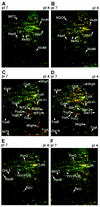Proteomic approach to understanding antibiotic action
- PMID: 12604526
- PMCID: PMC149304
- DOI: 10.1128/AAC.47.3.948-955.2003
Proteomic approach to understanding antibiotic action
Abstract
We have used proteomic technology to elucidate the complex cellular responses of Bacillus subtilis to antimicrobial compounds belonging to classical and emerging antibiotic classes. We established on two-dimensional gels a comprehensive database of cytoplasmic proteins with pIs covering a range of 4 to 7 that were synthesized during treatment with antibiotics or agents known to cause generalized cell damage. Although each antibiotic showed an individual protein expression profile, overlaps in the expression of marker proteins reflected similarities in molecular drug mechanisms, suggesting that novel compounds with unknown mechanisms of action may be classified. Indeed, one such substance, a structurally novel protein synthesis inhibitor (BAY 50-2369), could be classified as a peptidyltransferase inhibitor. These results suggest that this technique gives new insights into the bacterial response toward classical antibiotics and hints at modes of action of novel compounds. Such a method should prove useful in the process of antibiotic drug discovery.
Figures


References
-
- Antelmann, H., J. Bernhardt, R. Schmid, H. Mach, U. Volker, and M. Hecker. 1997. First steps from a two-dimensional protein index towards a response-regulation map for Bacillus subtilis. Electrophoresis 18:1451-1463. - PubMed
-
- Bandow, J. E., D. Becher, K. Büttner, F. Hochgräfe, C. Freiberg, H. Brötz, and M. Hecker. The role of peptide deformylase in protein biosynthesis-a proteomic study. Proteomics, in press. - PubMed
-
- Bernhardt, J., K. Buttner, C. Scharf, and M. Hecker. 1999. Dual channel imaging of two-dimensional electropherograms in Bacillus subtilis. Electrophoresis 20:2225-2240. - PubMed
Publication types
MeSH terms
Substances
LinkOut - more resources
Full Text Sources
Other Literature Sources
Medical

